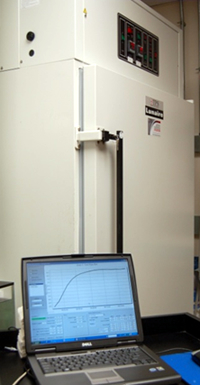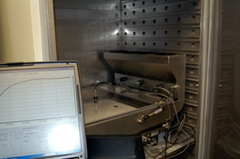Guarded Sweating Hot Plate Instrumentation
Comfort – Total Heat Loss

One of the primary functions of clothing is provision of comfort for the end user. Clothing comfort is often defined as the absence of discomfort. Often perceptions of discomfort are sensed when clothing materials impede the flow of heat and moisture from the body.
Measurement of a material’s ability to transfer both body heat and moisture into a designated environmental condition is done using sweating skin instrumentation. The guarded sweating hot plate measures heat flow from the calibrated test plate (heated to a skin surface temperature of 35°C) through the material into the test environment (25°C, 65%RH) and is determined for both simulated dry and wet skin conditions.

The sweating skin instrumentation, when used in a dry state, measures dry heat transfer with outputs used to calculate thermal resistance / insulation values (clo). Following the dry test, the instrument is fed water and made to “sweat.” The instrument, when used in a sweating state, uses the heat transfer results to calculate evaporative resistance. These measurements also provide a picture of the permeability, breathability, and heat loss from sweat evaporation.
Measurements obtained from both the dry and wet test plates are combined to calculate Total Heat Loss (W/m2). The Total Heat Loss (THL) value is an indicator of the total amount of heat transferred through the test material from a fully sweating test plate surface into the test environment. THL, measured at a 100% wet skin condition, indicates the highest predicted metabolic activity level that a wearer may sustain and still maintain body thermal comfort while in a highly stressed state in the test environment. Because, the sweating hot plate does not consider effects such as insulating air layers, garment design, and fit, the THL value represents the highest theoretically possible amount of heat that can be transferred through a material system for a given set of environmental conditions without active cooling or ventilation.
All heat and moisture transfer properties determined using this method are calculated from measurements of thermal transport made with the large skin model hot plate instrumentation. These measurements are made in accordance with the requirements of American Society Testing and Materials (ASTM) F1868 Standard Test Method for Thermal and Evaporative Resistance of Clothing Materials and/or ISO 11092 Textiles – Physiological effects – Measurement of thermal and water-vapour resistance under steady-state conditions (sweating guarded-hotplate test). THL measurements per ASTM F1868, Part C are also required by several National Fire Protection Association (NFPA) standards:

NFPA 1971: Standard on Protective Ensembles for Structural Fire Fighting and Proximity Fire Fighting (2007)
NFPA 1951: Standard on Protective Ensembles for Technical Rescue Incidents (2007)
NFPA 1977: Standards on Protective Clothing and Equipment for Wildland Fire Fighting (2011)
NFPA 1994: Standard on Protective Ensembles for First Responders to CBRN Terrorism Incidents (2007)
NFPA 1999: Standards on Protective Clothing for Emergency Medical Operations (2008)
The large sweating hot plate requires a 20″ x 20″ material swatch. In cases where materials of this size cannot be provided, a smaller plate option that uses a 5″x5″ swatch is available. It can be used to make similar measurements as the large plate, but does not follow any published standard.